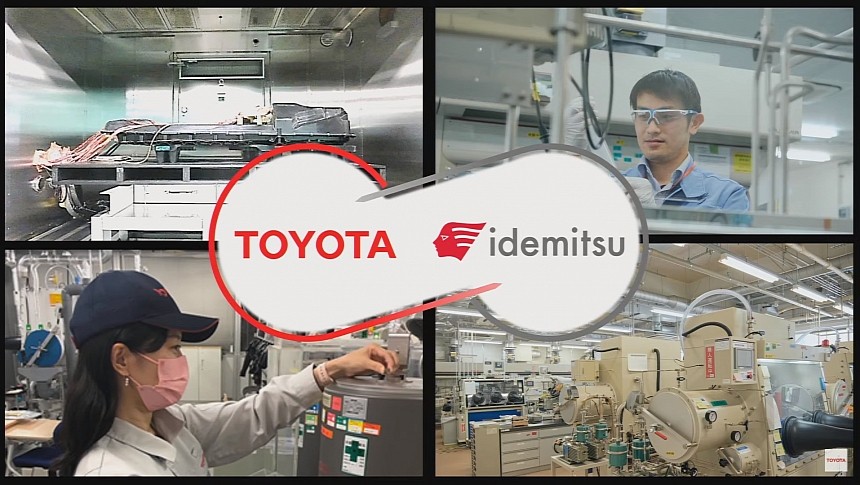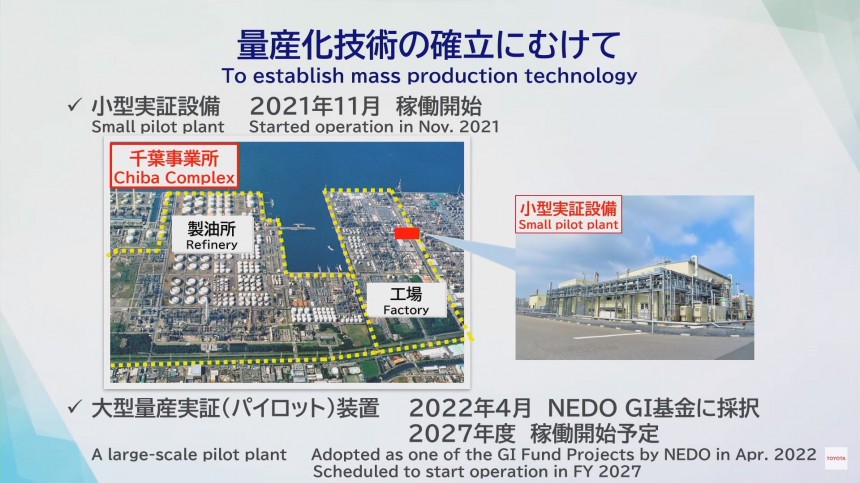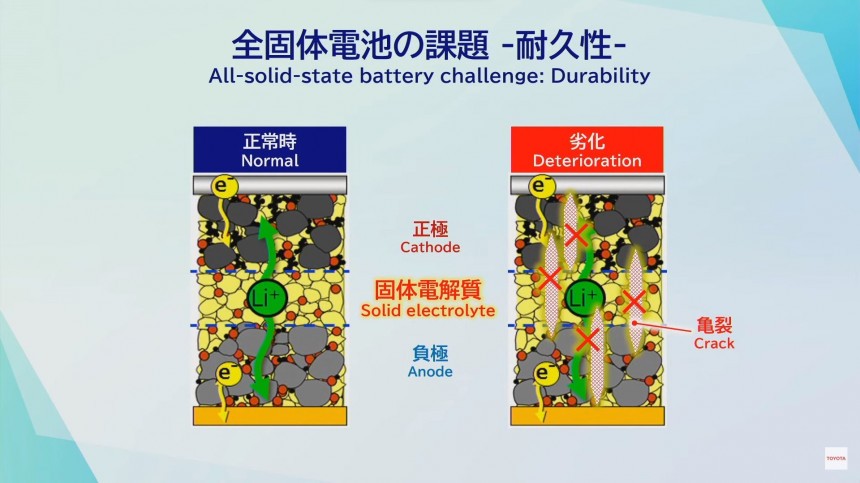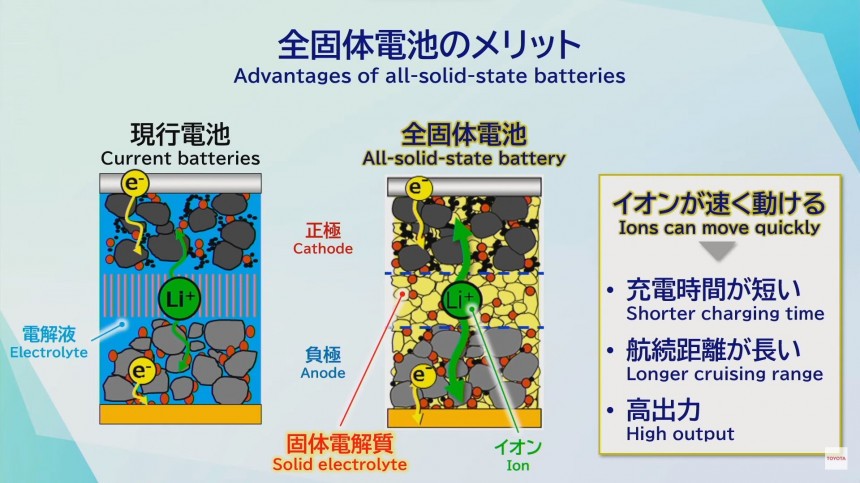Toyota seems resolute in making battery electric vehicles (BEVs) after it achieved a breakthrough in its quest to make solid-state batteries (SSB). This appears to be what changed the company's strategy around electrification. Curiously, one of its main partners to reach that goal will be Idemitsu Kosan. This Japanese oil company is the second largest in oil extraction and refinement in its home market, beaten only by Eneos. Together, the two companies shared more details about the new cells.
Idemitsu Kosan's CEO was pretty candid to admit that it started researching new materials for batteries after it realized that it could not rely on oil forever. According to Shunichi Kito, that was the reason for the company to focus its research and development (R&D) efforts in that direction. In 1994, it established a manufacturing technology to make lithium sulfide (Li2S), a component that seems to be crucial to Toyota's SSB. The Japanese company obtains sulfur in the process of desulfurization of oil products.
Idemitsu Kosan did not stop there. In 2001, research on solid electrolytes (SEs) began. Ironically, Toyota and the oil company changed that date to 2021 in their translation to English in one of the slides from their joint presentation. Thankfully, the timeline makes that very clear. Toyota would only start its solid-state battery research in 2006, five years later. It is not clear how the companies learned about each other's efforts, but they joined forces in 2013.
Together, Toyota and Idemitsu Kosan have 195 patents related to sulfide-based solid electrolytes. Curiously, the patent for the material representing a breakthrough in the battery the Japanese automaker wants to manufacture belongs to Toyota. That said, the oil company will only help it manufacture this material. The pilot plant will even be in an oil refinery that Idemitsu Kosan has in Chiba.
That's a different approach than that adopted by QuantumScape, which developed a ceramic separator that is separated from the cathode by "an organic gel electrolyte" – the catholyte. In the formation phase, lithium ions cross the separator and form a lithium metal anode on the opposite side of the cathode. This is the main advantage QuantumScape sees in its technology, but it mentioned others.
Solid Power also has a sulfide-based solid electrolyte, something QuantumScape said it did not want because the sulfide can react with the air and create hydrogen sulfide, a toxic gas. Toyota and Idemitsu Kosan said the material developed by the Japanese carmaker had been designed precisely with that risk in mind. The companies ensure the material actively avoids that. It is also moisture-resistant. Hydrogen sulfide may form sulfuric acid in contact with water.
In Toyota's case, drawings suggest the electrolyte is the solid-state element of the cell. Apart from that, the Japanese carmaker's SSB's anode and cathode are conventional. Apparently, there is no need for a separator because the solid electrolyte makes sure the cathode and the anode will never touch – which would cause a short circuit. Toyota's CEO talked about the challenges this material had to face.
The solid electrolyte had to be flexible. If it were too rigid, it could face cracks that would make the cell lead a very brief life. It also had to adhere both to the cathode and the anode, which ensures that the lithium ions traveling from one to the other would never experience a gap in their way. It seems that Toyota developed a material that complies with all requirements. Koji Sato said that this solves just part of the problem. The main challenge now is to find a way to mass produce this material and the solid-state cells the Japanese automaker needs.
Several journalists asked why Toyota and Idemitsu Kosan would wait at least four years to make that happen. Sadly, no executive explained that. They only repeated that the new SSB should arrive somewhere between 2027 and 2028 but did not offer any reason for that to take so long. I cannot think of many.
Toyota is known for being extra careful with all decisions it takes. That said, the new SSB may depend on extensive validation before it is put for sale in the company's new BEVs. Another possibility is that the Japanese carmaker does not want to release a car with SSBs earlier than it already said it would because such a car would make all its other products obsolete. Finally, it may have estimated it would achieve full development by 2028 and is just hoping for the best, even without anything to give these intentions any hope. This is something Tesla and Elon Musk would do, but not Toyota.
Whatever the reason is, the Japanese company has already presented a concept car with solid-state cells in 2020. To be honest, Toyota once said it would test its solid-state batteries in hybrid vehicles before it put them in BEVs because that would be a more demanding use to evaluate them. The automaker recently announced that the plans have changed and that BEVs will be the first ones to have them. At the same time, Toyota wants to offer specific solutions for each market, meaning it will sell whatever it is allowed to trade in its main markets.
If the Chinese government wants people to purchase BEVs, Toyota will sell them there. If Japan bets on hydrogen, so be it: the company will have such products in its home market. Countries that bet on renewable fuels, such as Brazil, will still have flex-fuel hybrids. That may go against the idea of having just a few projects to sell all over the world, increasing scale as much as possible. The world's largest carmaker does not seem to be worried about that as long as it is still able to sell the most suitable vehicles for each country. Let's see how SSBs will change that.
Idemitsu Kosan did not stop there. In 2001, research on solid electrolytes (SEs) began. Ironically, Toyota and the oil company changed that date to 2021 in their translation to English in one of the slides from their joint presentation. Thankfully, the timeline makes that very clear. Toyota would only start its solid-state battery research in 2006, five years later. It is not clear how the companies learned about each other's efforts, but they joined forces in 2013.
Together, Toyota and Idemitsu Kosan have 195 patents related to sulfide-based solid electrolytes. Curiously, the patent for the material representing a breakthrough in the battery the Japanese automaker wants to manufacture belongs to Toyota. That said, the oil company will only help it manufacture this material. The pilot plant will even be in an oil refinery that Idemitsu Kosan has in Chiba.
Solid Power also has a sulfide-based solid electrolyte, something QuantumScape said it did not want because the sulfide can react with the air and create hydrogen sulfide, a toxic gas. Toyota and Idemitsu Kosan said the material developed by the Japanese carmaker had been designed precisely with that risk in mind. The companies ensure the material actively avoids that. It is also moisture-resistant. Hydrogen sulfide may form sulfuric acid in contact with water.
In Toyota's case, drawings suggest the electrolyte is the solid-state element of the cell. Apart from that, the Japanese carmaker's SSB's anode and cathode are conventional. Apparently, there is no need for a separator because the solid electrolyte makes sure the cathode and the anode will never touch – which would cause a short circuit. Toyota's CEO talked about the challenges this material had to face.
Several journalists asked why Toyota and Idemitsu Kosan would wait at least four years to make that happen. Sadly, no executive explained that. They only repeated that the new SSB should arrive somewhere between 2027 and 2028 but did not offer any reason for that to take so long. I cannot think of many.
Toyota is known for being extra careful with all decisions it takes. That said, the new SSB may depend on extensive validation before it is put for sale in the company's new BEVs. Another possibility is that the Japanese carmaker does not want to release a car with SSBs earlier than it already said it would because such a car would make all its other products obsolete. Finally, it may have estimated it would achieve full development by 2028 and is just hoping for the best, even without anything to give these intentions any hope. This is something Tesla and Elon Musk would do, but not Toyota.
If the Chinese government wants people to purchase BEVs, Toyota will sell them there. If Japan bets on hydrogen, so be it: the company will have such products in its home market. Countries that bet on renewable fuels, such as Brazil, will still have flex-fuel hybrids. That may go against the idea of having just a few projects to sell all over the world, increasing scale as much as possible. The world's largest carmaker does not seem to be worried about that as long as it is still able to sell the most suitable vehicles for each country. Let's see how SSBs will change that.





























